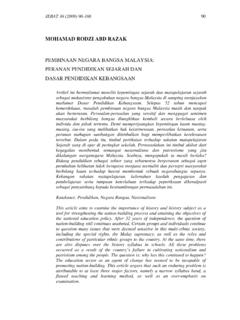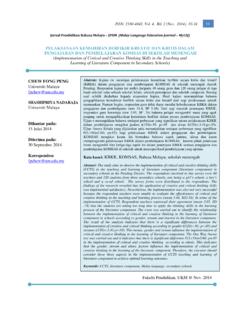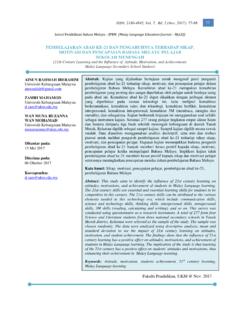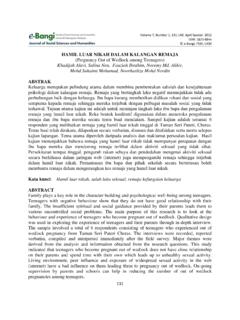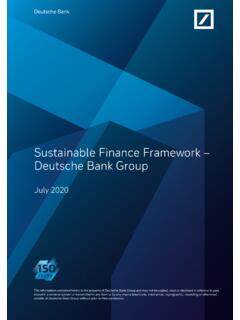Transcription of Exploring the managing of flood disaster: A Malaysian ...
1 GEOGRAFIA OnlineTM Malaysian Journal of Society and Space 14 issue 3 (24 - 36) 24 2018, e-ISSN 2680-2491 Exploring the managing of flood disaster: A Malaysian perspective Izham Mohamad Yusoff , Aznarahayu Ramli, Nurul Azni Mhd Alkasirah, Norashila Mohd Nasir School of Distance Education, Universiti Sains Malaysia Correspondence: Izham Mohamad Yusoff (email: Abstract Flooding occurs periodically in Malaysia and has become a common occurrence. This annual occurrence of floods has given a big impact on lives of humans and other living being. Due to the negative impact of floods, we need to pay serious attention and take an alternatives way to reduce this disaster. This paper reviews previous articles relating to flood disaster management in Malaysia based on electronic databases which are subscribed by the university library.)
2 The flood disaster management in Malaysia involves four phases, which are prevention/mitigation, preparedness, response and recovery. The disaster prevention/mitigation and preparedness are the best way forward because if these two phases were successfully handled, the burden of the next phases will be reduced. Besides, the agencies responsible for the management of floods in Malaysia have been identified in this study. The usage of technology for managing flood events has also been reviewed. The role of communities affected by the floods is no less important. Their awareness and readiness in facing the flood disaster are indispensable so that the negative impacts resulted from the disasters can be minimised. Therefore, the community should be educated to improve their awareness regarding flood management especially on how and what to prepare for flood as well as how to react during the flood .
3 Keywords: disaster management phases, flood disaster management , flood preparedness, flood recovery, Geographic Information System, prevention/mitigation Introduction Over the last three decades, flooding is a major risk in the world and nowadays it is becoming common in Malaysia. It has caused loss of lives and destruction of properties(Kourgialas & Karatzas, 2011). It is one of the natural disasters that prevents the development of a country (Elias et al., 2013). The changes of flood trends are due to changes of climate, use of land, growth of urban and human activities such as deforestation and infrastructure development across the watercourse (Amini et al., 2011; Kourgialas & Karatzas, 2011). In Malaysia, past researches showed that flood is the most common disaster affecting a number of areas especially the low area since 1920s.
4 Past researches stated that almost 9% of the total disaster is caused by the widening of the area while almost 22% of the total population is directly affected by floods ( Salleh et al., 2013; Othman et al., 2014; Aliagha et al., 2015; Khalid & Shafiai, 2015; Tan et al., 2015). Indeed, the flood disaster is expected to keep rising in line with the increase of migration from the rural residents to the cities, changes in the structure of soil which is caused by uncontrolled development, poverty and GEOGRAFIA OnlineTM Malaysian Journal of Society and Space 14 issue 3 (24 - 36) 25 2018, e-ISSN 2680-2491 other factors that threaten the floodplain areas (Mustaffa et al., 2014). Floods often occur in Malaysia due to the increase in the frequency of rainfall and the rise of the level of the sea in certain parts of the country (Aliagha et al.)
5 , 2015). Furthermore, the condition of climate in Malaysia is experiencing rainfall with the average of approximately 2,500 mm a year in Peninsular Malaysia, 3,000 mm a year in Sabah and 3,500 mm a year in Sarawak (Tahir, 2009; Khalid & Shafiai, 2015; Tan et al., 2015) making it as a common natural disaster in Malaysia (Othman et al., 2014). Specifically, there are two types of flooding that usually occur in Malaysia which are monsoon flood and flash flood . Monsoon flood normally happens around the month of May until August (Southwest Monsoon) and around the month of November until February (Northeast Monsoon) (Austin & Baharuddin, 2012; Tan et al., 2015). On the other hand, flash flood usually happens in the busy city. It is caused by the uncontrolled human activities such as infrastructure development near the river areas and uncontrolled littering causing clogged drains and waterways (Othman et al.
6 , 2014; Sipon et al., 2015). This situation is definitely worrying to the public as it has a negative impact on life, property, infrastructure, agriculture, human health and economic status which are affecting the community s quality of life (Austin & Baharuddin, 2012; Elias et al., 2013; Abram et al., 2014; Aliagha et al., 2015; Hammond et al., 2015). Therefore, efforts need to be implemented to resolve the problem. The effectiveness of flood disaster management should be given attention so that this situation cause by the disaster can be alleviated (Othman et al., 2014). Hence, this paper intends to get the information about how the flood issues have been managed in Malaysia as reported in the published literature. Method and data extraction The present researchers reviewed the information of flood issues by accessing the electronic databases subscribed from the university library ( Ebscohost, Emerald, Proquest and Science Direct).
7 The document and reports provided by the relevant agencies in Malaysia were also reviewed. The agencies involved are the Department of Irrigation and Drainage as well as the Department of Meteorology. In addition, the references in the manuscripts were also reviewed in searching for any additional study related to the current research. The limitation of dates has not been assigned so that most of the studies related to flood disaster management in Malaysia were identified. The titles and abstracts were then screened in order to achieve the required criteria that includes the full-text manuscripts available and discussions about flood disaster in the context of Malaysia. The method of study were not limited to either quantitative or qualitative. Table 1 provides the search criteria applied in this study.
8 Table 1. Search criteria Database Search terms EBSCOHOST flood AND disaster AND management AND Malaysia [Refine results: Full text; Malaysia; Journals; and Academic Journals] EMERALD flood AND disaster AND management AND Malaysia [Refine results: natural disasters, disasters, floods] PROQUEST flood AND disaster AND management AND Malaysia [Refine results: social science, disasters, disaster relief, climate change, floods] SCIENCE DIRECT flood AND disaster AND management AND Malaysia [Refine results: full text] GEOGRAFIA OnlineTM Malaysian Journal of Society and Space 14 issue 3 (24 - 36) 26 2018, e-ISSN 2680-2491 The full-text data extractions of the manuscripts were then screened. The data extraction includes author, year, journal, database and purpose of study. As the purpose of this study is to identify the management of floods in Malaysia, the manuscripts were then reviewed to find three types of information which are flood disaster management phases, the agencies involved and the use of technologies.
9 The search on electronic databases produced 81 titles and abstracts. However, a total of 19 manuscripts were selected for full-text review for data extraction after going through the basic screening using inclusion criteria including full-text manuscripts available, flood disaster and within Malaysian context. Table 2 presents the search results of this study. Table 2. Search results Database Search terms #of titles and abstracts # of titles and abstracts after screening EBSCOHOST (Academic, Business, Education, Psychology, etc.) Academic Search Complete flood AND disaster AND management AND Malaysia [Refine results: Full text; Malaysia; Journals; and Academic Journals] 33 5 EMERALD flood AND disaster AND management AND Malaysia [Refine results: natural disasters, disasters, floods] 14 7 PROQUEST flood AND disaster AND management AND Malaysia [Refine results: social science disasters, disaster relief, climate change, floods] 6 2 SCIENCE DIRECT flood AND disaster AND management AND Malaysia [Refine results: full text] 28 5 The full-text was reviewed for data extraction which includes author, year, journal, database and the purpose of the study.
10 The results of the data extraction are presented in Table 3. Based on the finding, the manuscripts were published between the years 1995 to 2016. The subsequent sections will discuss on the current flood management in Malaysia, the agencies involved and the use of technology in flood management in Malaysia found during the review process. Table 3. Data extraction results Author(s) / Year Database / Journal Purpose Amini et al. (2011) EBSCOHOST Arabian Journal for Science and Engineering To assess the effects of land-use changes and predict the effects of two future land-use scenarios on the flood regime of the Damansara Watershed using hydrologic models and spatial data. Austin and Baharuddin (2012) EBSCOHOST Kajian Malaysia To examine the agricultural risk factors and the policies in place for countering them.
